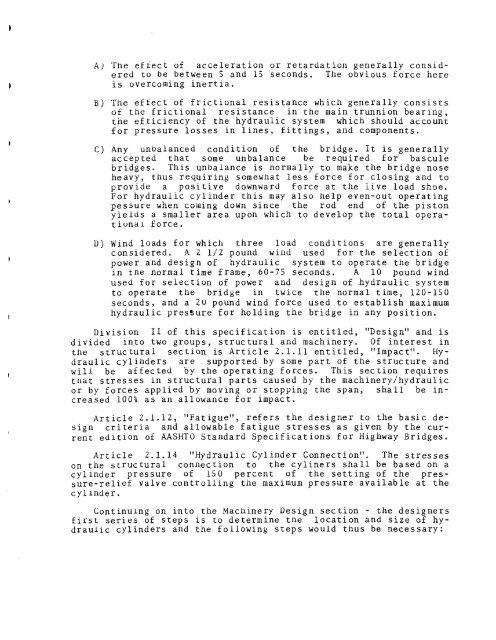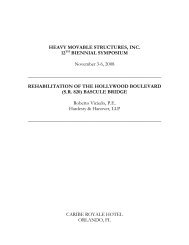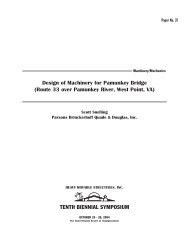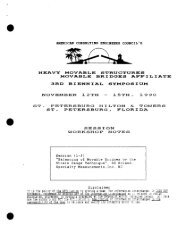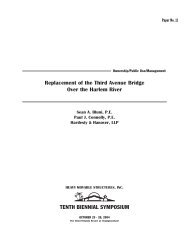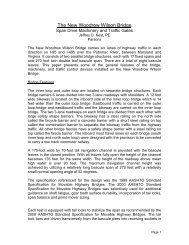AASHTO Design Criteria Applied to Hydraulic Bascule Bridges
AASHTO Design Criteria Applied to Hydraulic Bascule Bridges
AASHTO Design Criteria Applied to Hydraulic Bascule Bridges
You also want an ePaper? Increase the reach of your titles
YUMPU automatically turns print PDFs into web optimized ePapers that Google loves.
A) The effect of acceleration or retardation generally considered<strong>to</strong> be between 5 and 15 seconds. The obvious force hereis overcoming inertia.B) The effect of frictional resistance which generally consistsof the frictional resistance in the main trunnion bearing,the efticiency of the hydraulic system which should accountfor pressure losses in lines, fittings, and components.C) Any unoalanced condition of the bridge. It is generallyaccepted that some unbalance be required for basculebridges. This unbalance is normally <strong>to</strong> make the bridge noseheavy, thus requiring somewhat less force for closing and <strong>to</strong>provide a positive downward force at the live load shoe.For hydraulic cylinder this may also help even-out operatingpessure when co~riing down since the rod end of the pis<strong>to</strong>nyields a smaller area upon which <strong>to</strong> develop the <strong>to</strong>tal operatiunalforce.D) Wind loads for which three load conditions are generallyconsidered. A 2 1/2 pound wind used for the selection ofpower and design of hydraulic system <strong>to</strong> operate the bridgeIn tne normal time frame, 60-75 seconds. A 10 pound windused for selection of power and design of hydraulic system<strong>to</strong> operate the bridge in twice the normal time, 120-150seconds, and a 20 pound wind force used <strong>to</strong> establish maximumhydraulic pressure for holding the bridge in any position.Division I1 of this specification is entitled, "<strong>Design</strong>" and isdivided in<strong>to</strong> two groups, structural and machinery. Of interest inthe structural section is Article 2.1.11 entitled, "Impact". <strong>Hydraulic</strong>cylinders are supported by some part of the structure andwill be affected by the operating forces. This section requirestnat stresses in structural parts caused by the machinery/hydraulicor by forces applied by moving or s<strong>to</strong>pping the span, shall be increased100% as an allowance for impact.Article 2.1.12, "Fatigue", refers the designer <strong>to</strong> the basic designcriteria and allowable fatigue stresses as given by the currentedition of <strong>AASHTO</strong> Standard Specifications for Highway <strong>Bridges</strong>.Article 2.1.14 "<strong>Hydraulic</strong> Cylinder Connection". The stresseson the structural connecrion <strong>to</strong> the cyliners shall be based on acylinder pressure of 150 percent of the setting of the pressure-reliefvalve controlling the maximum pressure available at thecylinder.Continuing on in<strong>to</strong> the Machinery <strong>Design</strong> section - the designersfirst series of steps is <strong>to</strong> determine tne location and size of hydrauliccylinders and the following steps would thus be necessary:


